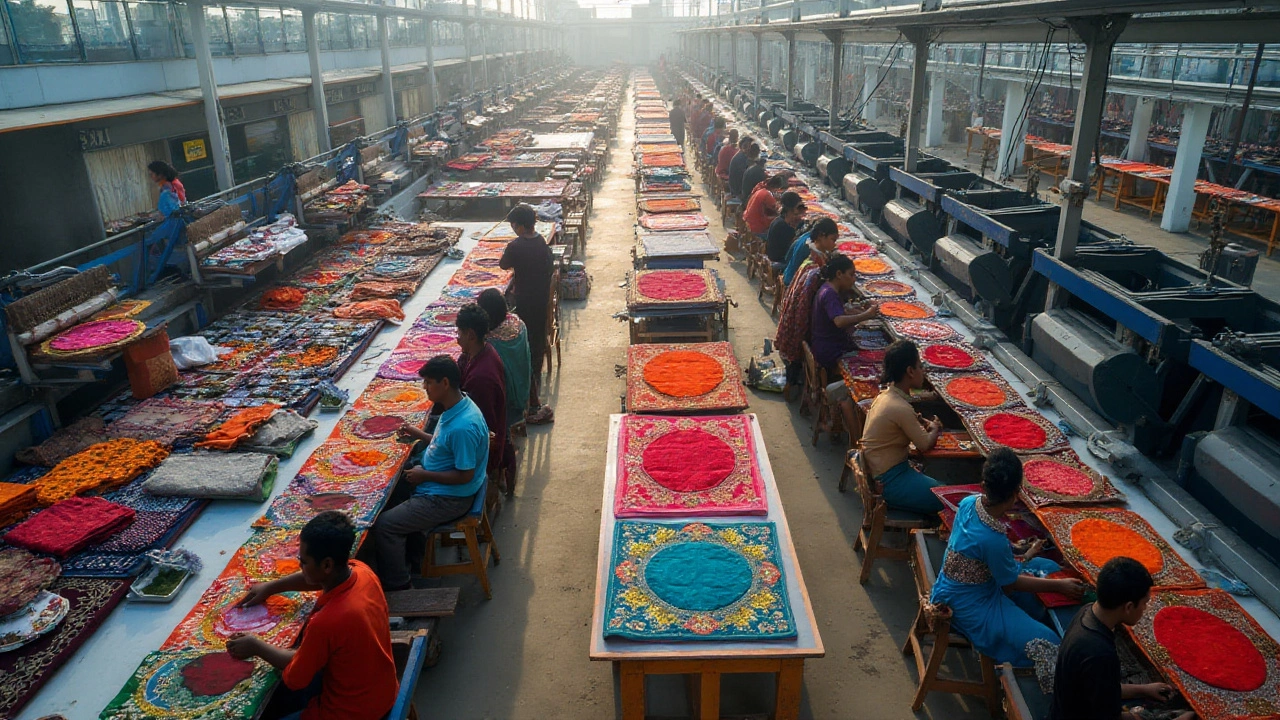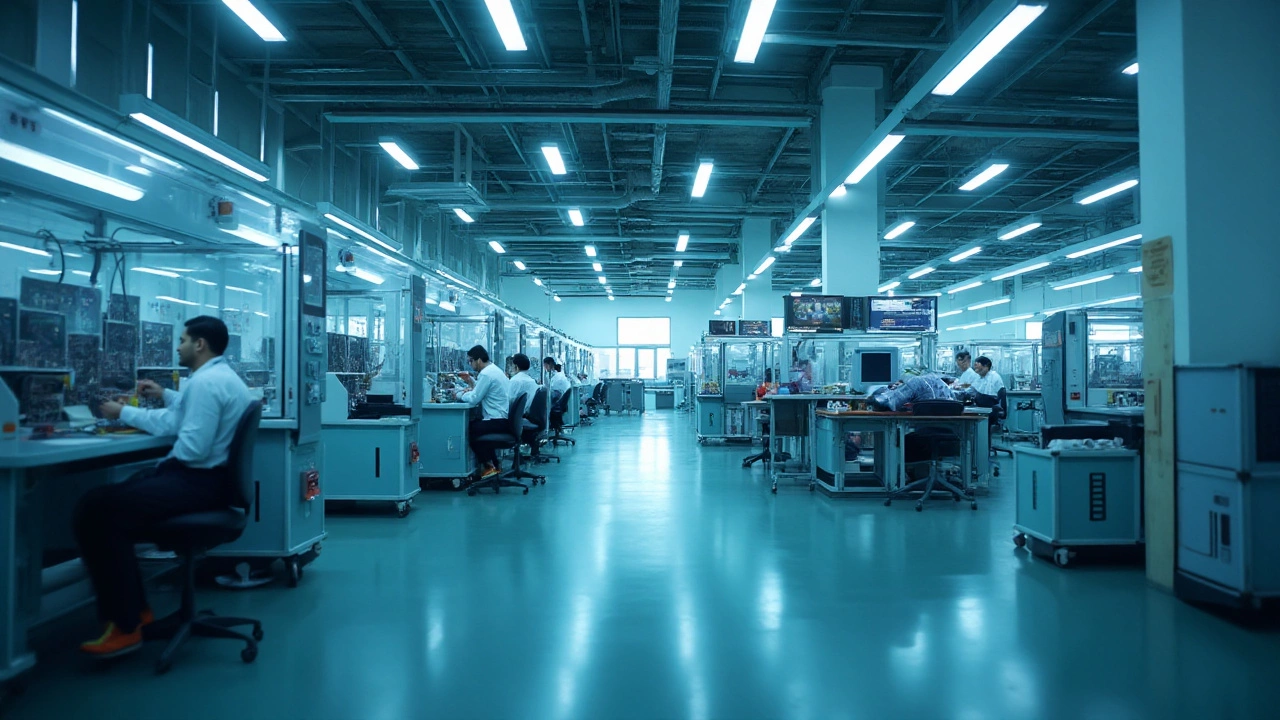Manufacturing has always been a cornerstone of economic growth and ingenuity, consistently evolving with technological advancements and consumer demands. However, not all manufacturing sectors are created equal when it comes to profitability. In today's fast-paced global marketplace, understanding which industries are making the most money and why can unlock valuable insights for entrepreneurs and investors.
From electronics and pharmaceuticals to automobiles and textiles, some sectors have outpaced others in terms of financial gain. We'll dive into these industry giants, analyzing what makes them so lucrative. As technology and innovation steer the manufacturing landscape, the path to success often involves adaptability and strategic foresight.
Identifying trends and emerging opportunities can provide a roadmap for those looking to make a mark in the manufacturing world. This article aims to explore the high-earning sectors, the influences behind their success, and the future prospects that lie ahead for potential entrepreneurs poised to enter the field.
Industry Overview
The world of manufacturing has undergone seismic shifts over the last few decades. What was once dominated by heavy industries like steel and coal has transformed into a diverse ecosystem of technologically advanced sectors. One of the driving forces behind this revolution is the continuous integration of information technology, leading to the Fourth Industrial Revolution or Industry 4.0. This era is characterized by smart factories where cyber-physical systems and the Internet of Things (IoT) are commonplace, enabling more efficient and adaptable manufacturing processes. The result is a landscape where precision, speed, and innovation are paramount, reshaping how manufacturing is perceived and executed globally.
Several sectors stand out in today's profitable industry terrain. The electronics industry has emerged as an undeniable leader, fueled by the insatiable global demand for gadgets, computers, and smart devices. This sector's rapid development has been extraordinary, driven by advancements in components like semiconductors and microchips. Not far behind, the pharmaceutical industry continues to thrive, particularly with heightened focus on healthcare and biotechnology innovations. In a post-pandemic world, the emphasis on vaccines, medications, and health technologies reinforces its critical and thriving role.
Interestingly, the automobile sector remains a significant player in modern manufacturing wealth generation. With the advent of electric vehicles (EVs) and sustainable mobility solutions, traditional manufacturers are reinventing themselves to meet environmental and regulatory demands. Meanwhile, the textile industry, often overlooked, maintains its relevance by pivoting towards smart textiles and sustainable practices. According to a study by McKinsey, the global textile market is projected to grow by 4% annually over the next five years, highlighting its resilience and capacity for innovation.
"Manufacturing is vital to the United States economy, and the advent of digital advances is transforming the sector into a vibrant source of high-paying jobs," states Gregory Hayes, CEO of a leading industrial conglomerate.
A closer look at sectorial profitability reveals that success is not merely about volume, but about value-added services and innovation. The integration of sustainable practices also plays a crucial role in staying competitive. Industries adopting renewable energy, reducing waste, and enhancing efficiency through technology are likely to gain an edge. As consumer awareness grows about environmental impact, companies that align their manufacturing ethos with such values not only achieve cost savings but also bolster their public image and market appeal.
In summary, the current manufacturing landscape is a dynamic tapestry woven with threads of tradition and innovation. Those who wish to excel must navigate the complexities of market dynamics and technological advancements, ensuring they stay ahead in this ever-evolving sector. Future prospects will favor those who blend strategic vision with the agility to adapt, making insightful, data-driven decisions to capitalize on emerging trends.

Leading Sectors
In the world of manufacturing, certain sectors have achieved incredible heights, sitting comfortably at the top of the profitability pyramid. One of the most prominent among these is the electronics industry. Bursting with innovation, it encompasses everything from smartphones and computers to advanced components like semiconductors. This sector has become indispensable with the surge in digital transformation across businesses and households alike. The growing dependence on electronic gadgets and devices propels this industry’s revenue, showcasing it as a lucrative option for both established players and newcomers focused on tech advancements.
The pharmaceutical industry is another sector enjoying substantial financial success. Driven by a combination of scientific breakthroughs and an ageing global population, this industry remains at the forefront due to its ability to innovate continually. New drug developments and advances in biotechnology have not only improved healthcare but have also created enormous profit margins. With increased global focus on health and wellness, particularly highlighted during recent pandemics, pharmaceuticals are projected to expand further. "Biopharmaceuticals alone generated over $237 billion in sales in 2020," notes a report from Statista, emphasizing the sector’s immense impact on the global economy.
Automobile manufacturing represents another significant player in the list of top-earning sectors. Known for its large-scale production and international reach, this industry has seen significant changes with the rise of electric vehicles and sustainable practices. Traditional car manufacturers are pivoting towards eco-friendly alternatives, creating vast opportunities for growth in an evolving market. As urbanization continues and the need for transportation solutions increases, the automobile sector's resilience and adaptability provide it with a stable and prosperous path forward.
The textile industry, often seen as one of humanity’s oldest manufacturing sectors, still plays a pivotal role in the global economy. It remains incredibly profitable due to its sheer scale and the constant demand for clothing and apparel. Despite challenges like fluctuating raw material costs and environmental concerns, innovation in materials and production processes keeps this industry thriving. From fast fashion to high-demand technical textiles, the sector offers vast potential for sustained growth and profitability.
The McKinsey Global Institute highlights, "Global flows in fashion and lifestyle will continue to evolve, driven by novel retail avenues, such as e-commerce, and increased consumer awareness about sustainability."These leading sectors exemplify the diverse opportunities within manufacturing, each driven by unique factors yet remaining united by the common thread of innovation and market demand.

Factors Driving Profitability
The profitability of a manufacturing industry hinges on a tapestry of interconnected elements that shape its economic outcomes. For starters, the scale of production plays a pivotal role. Industries that manufacture on a large scale benefit from economies of scale, which significantly reduces the cost per unit. This cost efficiency makes mass production especially advantageous for sectors like technology and consumer goods, where demand is high and constant innovation is paramount. When production is scaled, businesses enjoy lower input costs, and they distribute fixed costs across a larger volume of products, increasing margin per item.
Another critical factor is technological advancement. With rapid technological changes, sectors like electronics and pharmaceuticals enjoy substantial profit margins. Automation and AI have revolutionized traditional manufacturing methods, boosting productivity and reducing human error. These advancements not only speed up production processes but also enhance product quality, directly influencing consumer satisfaction and market demand. Manufacturing industries that swiftly adopt cutting-edge technology often experience a competitive edge, setting them apart in an ever-evolving marketplace.
The location of manufacturing facilities also significantly impacts profitability. Proximity to resources, skilled labor, and markets can dramatically reduce transportation and logistics costs. Countries with favorable governmental regulations and policies towards manufacturing, such as tax incentives and subsidies, tend to host more profitable industries. Emerging markets like India and Vietnam offer not only affordable labor but also access to burgeoning markets. By strategically positioning their operations, companies can tap into a wider customer base while maintaining lean operations.
Supply Chain Management
Effective supply chain management is another essential contributor to profitability in the manufacturing industry. Streamlined operations ensure that raw materials and finished products move efficiently through the production line, reducing delays and minimizing costs. Advanced logistics solutions and just-in-time inventory systems minimize waste and improve cash flow, which has a direct impact on a company’s bottom line. Companies that partner with reliable suppliers and maintain a flexible supply chain are better equipped to respond to market changes and reduce the risk of disruptions."Being prepared to adapt and optimize our supply chain in real-time is what sets the pros apart from the rest in the manufacturing world," remarked John Michael, an industry consultant with over two decades of experience. This adaptability becomes a competitive advantage, especially in fluctuating economic environments.
In essence, keen attention to these diverse factors not only helps in driving the profitability of a manufacturing industry but also ensures sustainable growth and competitive positioning in global markets. By leveraging technological innovations, optimizing production and supply chains, and selecting strategic locations, industries can maximize their potential revenue streams in this highly competitive field.

Future Opportunities
The manufacturing sector is seeing a wave of transformation driven by technological advancement, global economic shifts, and changes in consumer preferences. The evolution of smart manufacturing, often referred to as Industry 4.0, is at the forefront, integrating technologies such as the Internet of Things (IoT), artificial intelligence (AI), and robotics into the production process. These innovations not only boost efficiency but also enhance product customization, allowing companies to meet specific consumer demands with greater precision. As the industry adapts, opportunities open up for businesses to capitalize on these trends.
In particular, the adoption of smart technologies in manufacturing is poised to reshape how products are made. Companies that invest in these technologies can significantly reduce costs and improve quality control. For instance, predictive maintenance enabled by IoT devices helps foresee machine breakdowns, ensuring uninterrupted production and minimizing downtime. According to a McKinsey report, incorporating IoT in manufacturing can lead to a potential economic boost of up to $3.7 trillion by 2025. Such possibilities highlight the importance of technological investments for those looking to thrive in the evolving landscape.
Alongside technological integration, sustainable practices are gaining momentum as both a market demand and a necessity. Manufacturers are increasingly finding ways to reduce waste and carbon footprints, designing eco-friendly products that appeal to environmentally-conscious consumers. The push for sustainability is not merely a trend but a fundamental shift that offers opportunities for manufacturers to innovate. Incorporating recycled materials or developing energy-efficient processes can set a company apart, attracting a growing customer base that values responsible production. According to the World Economic Forum, sustainable manufacturing not only offers competitive advantages but is also predicted to be a major driver of new business models in the upcoming decades.
"Adopting sustainable practices and smart technologies is not just a choice for manufacturers; it's a crucial step towards long-term success and resilience," says Dr. Jane Smith, a noted economist specializing in industrial transformations.
Moreover, the post-pandemic world has underscored the importance of supply chain resilience. The disruptions experienced globally have prompted companies to reevaluate their strategies, focusing on diversifying suppliers or reshoring critical elements of their supply chain. This shift offers a chance for local manufacturers to once again become key players on the global stage. Entrepreneurs looking to enter the manufacturing game should consider the benefits of agile supply chain strategies, which make businesses more adaptable to unforeseen changes.
Finally, personalized and adaptive products are becoming increasingly crucial as consumers demand unique solutions that meet their specific needs. Manufacturers can leverage digitalization and data analytics to understand consumer trends better and offer tailored products that appeal directly to individual preferences. Customization can range from adaptive clothing designs to personalized electronic devices, offering a unique value proposition that stands out in a crowded market. Adapting these strategies not only satisfies consumer desires but also opens up new avenues for revenue generation, marking a fruitful path for future manufacturing ventures.










Write a comment